In session four we finally got to one of my favorite vocal exercises, speaking like bells. We used the line from one of our later readings: “There is no sleep so deep I would not hear you there.” Megan led this one and she asked different groups in the room to speak like different kinds of bells. We had little hand bells, bells about the size of the liberty bell, and the largest of giant cathedral bells. One of the more interesting things that happened was when the medium sized bells were given the instruction to think about the clapper’s motion as it strikes the sides of the bell and to use that to drive their words. After each group had tried their bell speaking solo it was time for that most magical of moments, group bell speaking. Most years we do this with the participants spread across the room, but this time we did it in a circle. I was participating in the circle too, with my tiny hand bell words, but as the last of the bells echoed to silence it was all I could do not to run to the center of the circle and demand everyone do it again. Even just imagining what it would have been like to be in the center of that circle gives me chills, but we have far too much work to do for me to spend their precious time fulfilling my own selfish desires, so I resisted the urge and we moved on.
Our next exercise was another we do every year called simply lay, sit, stand. The participants use a chair and explore on their own simply laying, sitting, and standing in relation to the chair. Then they work in groups of three with one chair between them and they switch between the three states, but only one person in the group can be in any state at a time, so if one person switches they all have to switch. It’s extremely interesting to watch this, especially seeing how differently the performances of each group can seem, when every group has been given the same instructions and are trying to solve the same problem.
For our first readings we discussed a few of Samuel Beckett’s late minimalist pieces. “Come and Go,” “Footfalls,” and “That Time.” In these pieces Beckett fulfills his theatrical intentions within the structure of the pieces themselves. The repetition of a moment over and over: a woman leaving and then returning to her friends on a bench they all share, a woman pacing ten steps one way then wheeling to pace back again and again, a man’s breathing and blinking. These stark images are accompanied by dialogue that only hints at the histories that led to these moments. The language in the most verbose of the three, “That Time” is especially evocative of the way our minds work as we try to make sense of past events in our heads. Three voices speak from three directions to the face of a man who simply blinks and breathes every now and again. The voices seem unable to speak with any authority of specific past events relaying only fragments, and impressions, revisions, and repetitions that come pouring out so fast that there is not even any punctuation in the written lines. In “Footfalls” an unseen speaker asks the woman pacing : “Will you never have done? Will you never have done . . . revolving it all? It all. In your poor mind. It all. It all.” The answer from the figure is silence as she continues pacing. No, we cannot ever be done revolving it all, it is in our nature and that nature is what Beckett has achingly displayed for us in highly theatrical form.
Our second reading was also about a fellow who cannot have done, but he confronts the mystery of his life in a far more frenetic fashion, imagining heroic scenarios and future successes while trying to keep his head above water. I am talking about the B Beaver, of course, star of The B Beaver Animation by Lee Breuer. The B Beave has lost “the art of damnation” at a crucial time and his attempts to get it back are hilarious and heartbreaking. Lee Breuer fills the stream of consciousness monologue of the beaver (meant to be performed by multiple people) with word play of every kind, references to pop culture low and high, and comic timing so fast it may whiz right by you. The story is relatively straight forward: The B Beav must provide for his family, he must solve the problem of his failing dam making skills. As he negotiates the hurdles the world throws in his path (many of which seem to be of his own making) he keeps up a constant flow of dialogue with the audience and himself about his problems and his attempts at solutions. The B Beav’s struggle is familiar to us all although you may not notice that right away, since he has a tendency to embellish things and is easily distracted. The B Beave speaks to all artists (and aren’t we all artists, really) who must walk that fine line between commitment to our art and commitment to, well, survival. For most of us, we can’t have one without the other, but they all too often seem to work against each other. We’re all in one way or another paying through the nose while hoping to cash in on the wages of love, just like the B Beave.
In light of these two readings a slow motion race was definitely in order. The participants run as hard as they possibly can towards the goal of the finish line, but the sprint must happen as slowly as they can possibly move. See what we did there?
Striving as hard as you can towards a goal like the B Beave, each moment lasting an eternity, like Beckett’s characters. After this slow motion race we did a little quartet work in chairs. In this exercise the participants are asked to maintain a neutral face and general seated physicality, but to use a set of defined gestures to interact with each other. They have only an arm raise, a leg cross, or a head turn with which to create their scene.
The best part of this one is when we watch each other doing the exercise. It illustrates beautiful how qualities of movement can communicate the things we usually rely on facial expressions for. Also, how we as humans cannot help but try to understand what we see in terms of a story. The audience always reacts to the “scenes” as though the things happening are funny or scary or shocking, but of course the performers are simply following a set of instructions. Two! — lightening crash– Two, excellent realizations for the rest of our work! Aah Aah Aah.
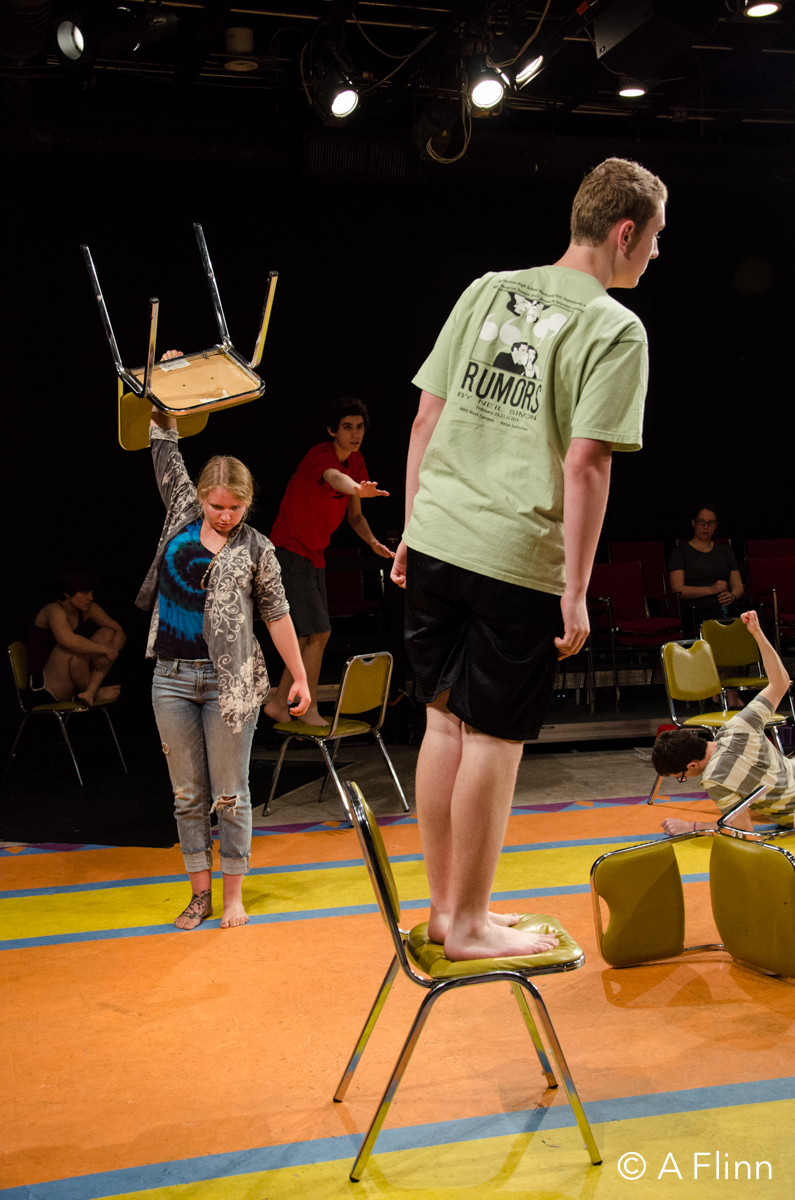
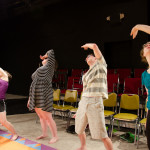
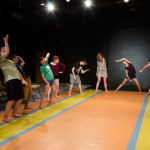
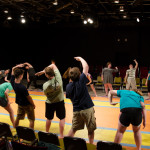
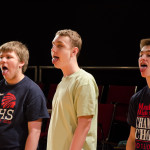
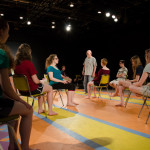
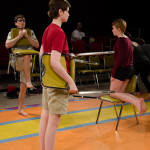
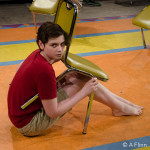
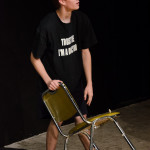
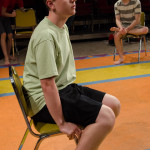
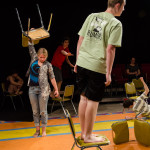
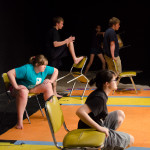
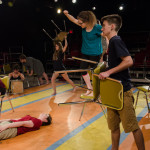
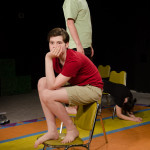
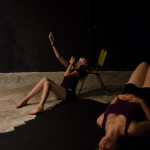
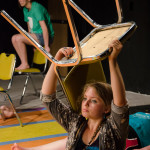
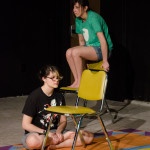
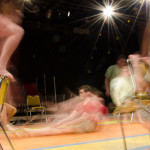
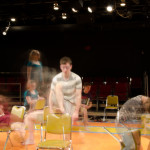
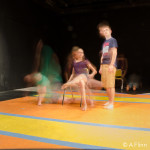
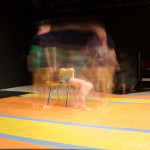
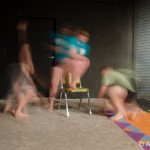
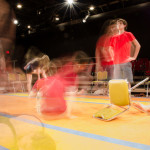
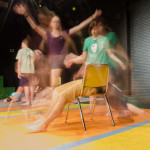
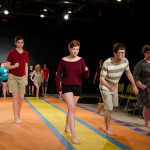
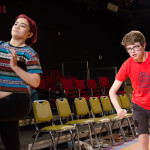
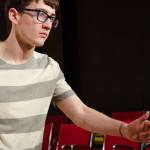
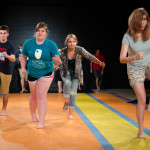
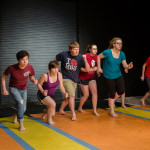
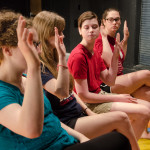
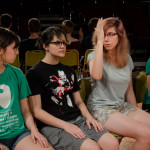
Leave a Reply
You must be logged in to post a comment.